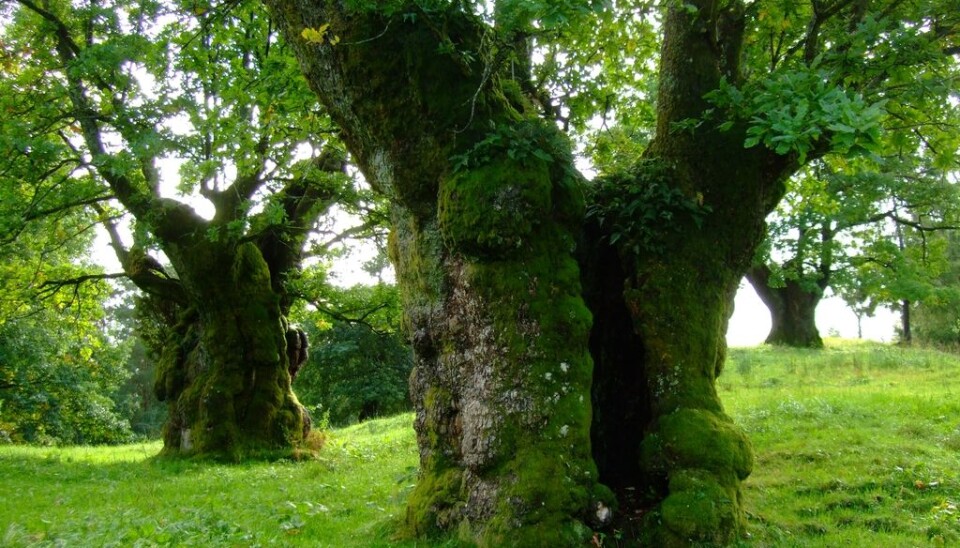An article from Norwegian University of Life Sciences (NMBU)

Hollow oaks are full of life
“It’s a considerable challenge for us to take better care of these trees,” says professor.
Denne artikkelen er over ti år gammel og kan inneholde utdatert informasjon.
Large and old oak trees have special properties lacking in younger trees. They have rougher bark, more dead branches in the crown, and more and bigger cavities in the trunk.
These cavities become full of wood mould, which looks like reddish-brown flour and consists of rotten wood, remnants of nests, dead insects, bird droppings, leaves, fungi, etc.
Many insects are dependent on this wood mould for food and as a habitat for their larvae. The cavities of oaks also house bats and hole-nesting birds in addition to insects.
Since 2012, researchers have been mapping areas with hollow oaks in Norway, and the recording will continue until 2016.
Full of life
“Although we do not have a great many oaks in Norway, the trees we have are very important for biodiversity,” says Professor Anne Sverdrup-Thygeson of the Norwegian University of Life Sciences (NMBU).
“In particular, we find many species in old, rough or hollow oaks. Many of these species have limited ecological habitat requirements and are uncommon in Europe as a whole. In Norway, many species that specialise in oaks are considered endangered, being threatened by fungi, lichens and insects,” she says.
The professor explaines that no two cavities are the same.
“They vary in size, type of decay and amount of tree mould. They can be dry or moist, in a sunny or shady position. Trees are also an important habitat for many organisms long after they are dead, and rough trees take longer to decompose when they die.”
Oaks are felled and die
Pending the results of the national survey of hollow oaks, the researchers conducted an example study in 2013 where they visited 30 locations described as having interesting oak tree environments 30 years ago.
In the autumn, they visited the oak tree sites and recorded whether the oaks were intact, felled or dead and documented this with photographs.
Of the 30 sites examined, seven had lost at least one oak. At five of the sites, oaks had apparently toppled over and died without any direct human action.
In the remaining two localities, one or more oaks had been chopped down.
“This suggests that we have a considerable challenge in taking better care of the hollow oaks we have in Norway,” concluded Professor Sverdrup-Thygeson.
Legal protection
In 2011, hollow oaks were designated as a “selected habitat type”. This special status applies to habitats that are declining, house rare species or for which Norway has an international responsibility.
A selected habitat type is guaranteed special preservation by the Nature Conservation Act. This implies that these trees must be preserved and that landowners with hollow oaks on their property must exercise due care to avoid damage to the habitat.
Since hollow oaks have a special legal status, it is especially important to have good ecological knowledge as a basis for conservation measures.
200 hollow oaks found
Within the range of oaks in Southern and Western Norway, researchers have randomly chosen 500 areas of 250,000 m2 in forests and farmland.
Extensive field work is well underway and all the areas are being thoroughly searched for oaks. Large oak trees are plotted, measured and described in detail.
So far, the researchers have found 200 hollow oaks. In addition, so-called recruitment trees are recorded. These are trees that in the long term can take over from the old and hollow oaks.
Recruitment trees take a couple of hundred years to become hollow oaks.
The researchers have extensive work ahead of them and plan to have completed recording oaks in all areas in 2016. They will then have sufficient data to provide a good estimate of how many hollow and rough oaks we have in Norway.
These data will then form the basis for continued monitoring of so-called hotspot habitats of hollow oaks. In the next round, the researchers will gain a better idea of changes in the number of hollow oaks in the country. Monitoring of the biodiversity in the oaks can also be linked in.
Knowledge of the biodiversity of hollow oaks
The national survey has provided scientists with a great deal of knowledge about biodiversity in such trees. There are about 60 red-listed species of beetles alone associated with hollow trees, particularly oaks.
“In a single hollow oak tree we have found up to 25 red-listed species of beetles,” says Sverdrup-Thygeson.
“Oak also stands out as the most important of our deciduous trees for red-listed fungi, although fungi are not directly dependent on oaks being hollow. Old oaks are also very important for red-listed lichens.”
------------






























